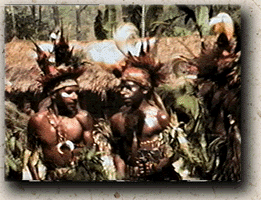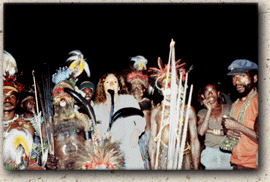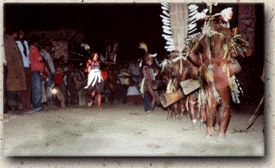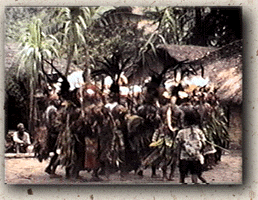
GOING NATIVE

W
hat it is not:
Old Playboy cartoons often portrayed semi-clad
male or female anthropologists eagerly shedding their scholarly, presumably
more civilized persona to engage in wild sex with the natives. This
popular image of what "going native" means was fueled by the more
respectable National Geographic. This magazine offered "scientific", but
nonetheless seductive and often false representations of the third world,
and especially the Pacific Islands, on a monthly basis to a burgeoning
middle-class eager to demonstrate its knowledge and sophistication
(see Lutz and Collins 1993). While anthropologists may be sexually
attracted to their informants and in a few cases participate in sexual
liaisons (see Kulick and Willson, eds., 1995), wild sex is very rarely a
part of fieldwork. No matter how lonely and disturbed, or adapted and
enamoured an anthropologist may become, most choose not to complicate their
lives in the field and not to take advantage of potential lovers whom they
will ultimately, in most cases, leave behind when they depart from the
field. Often, the anthropologist's hosts are every bit as concerned that
the anthropologist's sexuality be kept under control so as not to disturb
local relations or to constitute a threat to decent behavior (see Whitehead
and Conaway, eds. 1986).

Fieldwork at a personal level:
The anthropologist's sexual orientation and
gender, as well as their age, class, race, ethnicity, nationality, and
other aspects of their personality and individuality are of course relevant
in both their choice of fieldwork topics and in their experiences in the
field. Anthropology is a personal undertaking and in its best sense,
"going native" refers to the process of learning, adjusting, expanding,
and accepting that goes on as anthropologists deepen their involvement with
their hosts and their hosts' cultures through long-term fieldwork and
participation. This process of absorbing another culture is
 psychologically challenging. At times the
anthropologist will resist the process of assimilation, exhibiting signs of
neurosis and obsessive behavior, while at other times they will plunge
headlong into the lives and behaviors of their hosts, forgetting for a time
that they ever lived anywhere else. In spite of all the specialist, and
even necessary methodology anthropologists use in the field, much of the
learning process is unconscious. Only after I left the field did I discover
how much I had taken on the behaviors and assumptions of a normal Gende
woman. At crowded graduate student parties I found myself unable to step
over men's outstretched legs for fear that I
psychologically challenging. At times the
anthropologist will resist the process of assimilation, exhibiting signs of
neurosis and obsessive behavior, while at other times they will plunge
headlong into the lives and behaviors of their hosts, forgetting for a time
that they ever lived anywhere else. In spite of all the specialist, and
even necessary methodology anthropologists use in the field, much of the
learning process is unconscious. Only after I left the field did I discover
how much I had taken on the behaviors and assumptions of a normal Gende
woman. At crowded graduate student parties I found myself unable to step
over men's outstretched legs for fear that I
 would "harm" my friends with my
dangerous sexuality. Upon reuniting with family and friends in the United
States, I unselfconsciously hugged and petted them only to have my
greetings spurned by many, unused as most Americans are to "too much
physical contact" in non-sexual relationships. To this day, students and
others are often stunned by my directness, a trait I possessed before I
went to the field, but one which flourished in a social context in which
mature, socially responsible women will say what is on their minds and
even the smallest
would "harm" my friends with my
dangerous sexuality. Upon reuniting with family and friends in the United
States, I unselfconsciously hugged and petted them only to have my
greetings spurned by many, unused as most Americans are to "too much
physical contact" in non-sexual relationships. To this day, students and
others are often stunned by my directness, a trait I possessed before I
went to the field, but one which flourished in a social context in which
mature, socially responsible women will say what is on their minds and
even the smallest
 child is encouraged to stand
up for its interests. When it is all said and done, good fieldwork involves
relationships - some friendly, others more distant - in which you and at
least some of your hosts come to understand one another's lives and ways of
doing things. Two books that capture the nuances and relationship between
anthropology and friendship are Ruth Behar's revealing account of her work
and friendship with a Mexican market woman (1993) and Grindal and Salmone's
collection (1995) of fourteen narratives written by anthropologists working
in different parts of the world.
child is encouraged to stand
up for its interests. When it is all said and done, good fieldwork involves
relationships - some friendly, others more distant - in which you and at
least some of your hosts come to understand one another's lives and ways of
doing things. Two books that capture the nuances and relationship between
anthropology and friendship are Ruth Behar's revealing account of her work
and friendship with a Mexican market woman (1993) and Grindal and Salmone's
collection (1995) of fourteen narratives written by anthropologists working
in different parts of the world.
Copyright ©
1996 by Laura Tamakoshi and Brian
Cross



 psychologically challenging. At times the
anthropologist will resist the process of assimilation, exhibiting signs of
neurosis and obsessive behavior, while at other times they will plunge
headlong into the lives and behaviors of their hosts, forgetting for a time
that they ever lived anywhere else. In spite of all the specialist, and
even necessary methodology anthropologists use in the field, much of the
learning process is unconscious. Only after I left the field did I discover
how much I had taken on the behaviors and assumptions of a normal Gende
woman. At crowded graduate student parties I found myself unable to step
over men's outstretched legs for fear that I
psychologically challenging. At times the
anthropologist will resist the process of assimilation, exhibiting signs of
neurosis and obsessive behavior, while at other times they will plunge
headlong into the lives and behaviors of their hosts, forgetting for a time
that they ever lived anywhere else. In spite of all the specialist, and
even necessary methodology anthropologists use in the field, much of the
learning process is unconscious. Only after I left the field did I discover
how much I had taken on the behaviors and assumptions of a normal Gende
woman. At crowded graduate student parties I found myself unable to step
over men's outstretched legs for fear that I
 would "harm" my friends with my
dangerous sexuality. Upon reuniting with family and friends in the United
States, I unselfconsciously hugged and petted them only to have my
greetings spurned by many, unused as most Americans are to "too much
physical contact" in non-sexual relationships. To this day, students and
others are often stunned by my directness, a trait I possessed before I
went to the field, but one which flourished in a social context in which
mature, socially responsible women will say what is on their minds and
even the smallest
would "harm" my friends with my
dangerous sexuality. Upon reuniting with family and friends in the United
States, I unselfconsciously hugged and petted them only to have my
greetings spurned by many, unused as most Americans are to "too much
physical contact" in non-sexual relationships. To this day, students and
others are often stunned by my directness, a trait I possessed before I
went to the field, but one which flourished in a social context in which
mature, socially responsible women will say what is on their minds and
even the smallest
 child is encouraged to stand
up for its interests. When it is all said and done, good fieldwork involves
relationships - some friendly, others more distant - in which you and at
least some of your hosts come to understand one another's lives and ways of
doing things. Two books that capture the nuances and relationship between
anthropology and friendship are Ruth Behar's revealing account of her work
and friendship with a Mexican market woman (1993) and Grindal and Salmone's
collection (1995) of fourteen narratives written by anthropologists working
in different parts of the world.
child is encouraged to stand
up for its interests. When it is all said and done, good fieldwork involves
relationships - some friendly, others more distant - in which you and at
least some of your hosts come to understand one another's lives and ways of
doing things. Two books that capture the nuances and relationship between
anthropology and friendship are Ruth Behar's revealing account of her work
and friendship with a Mexican market woman (1993) and Grindal and Salmone's
collection (1995) of fourteen narratives written by anthropologists working
in different parts of the world.